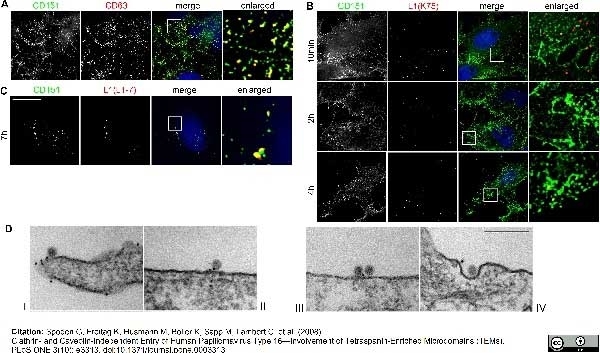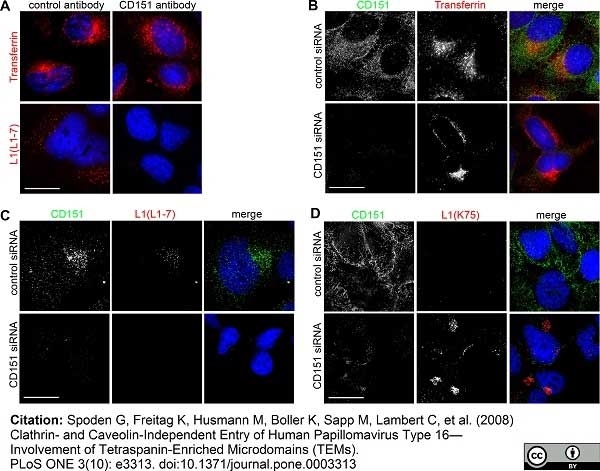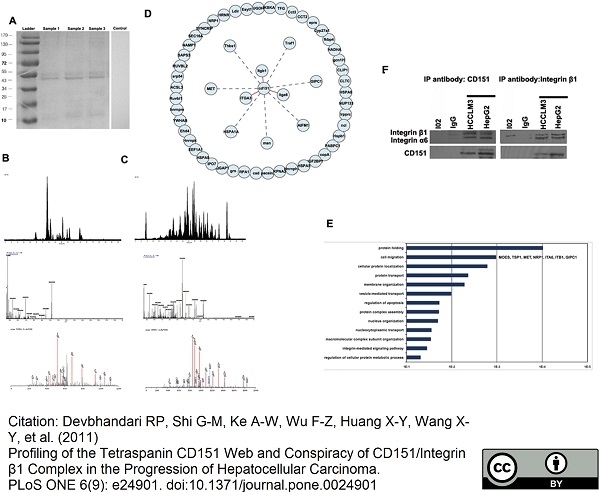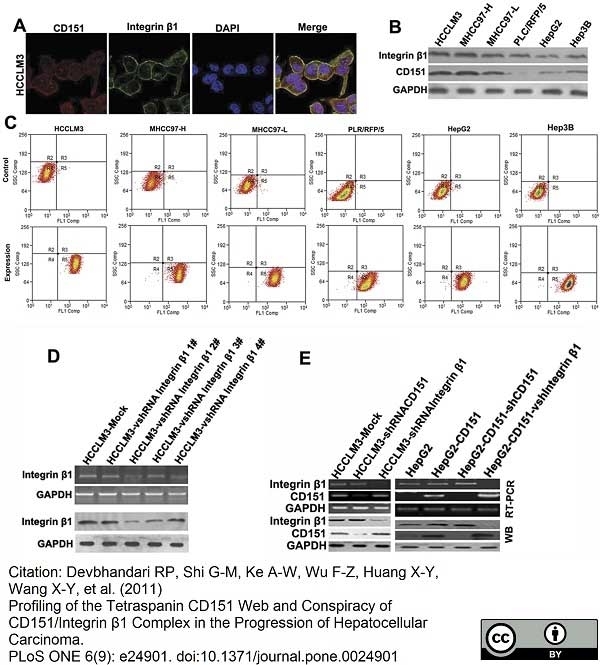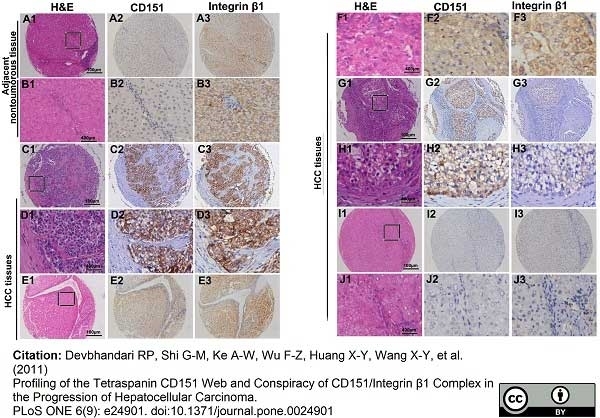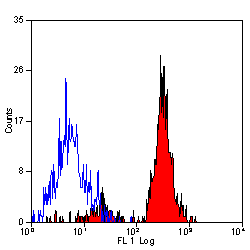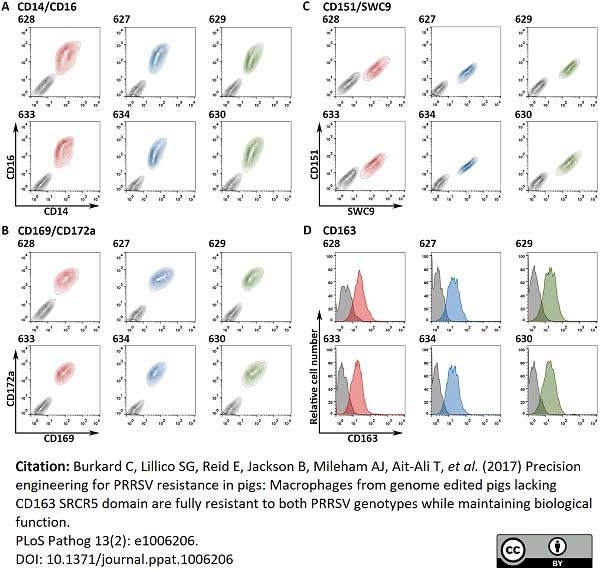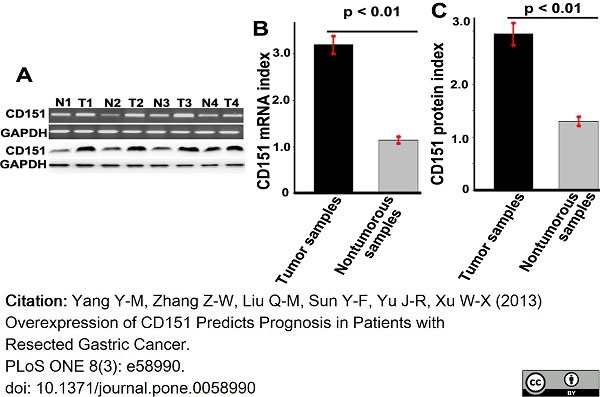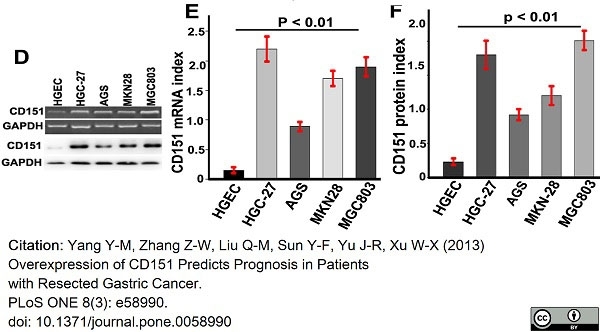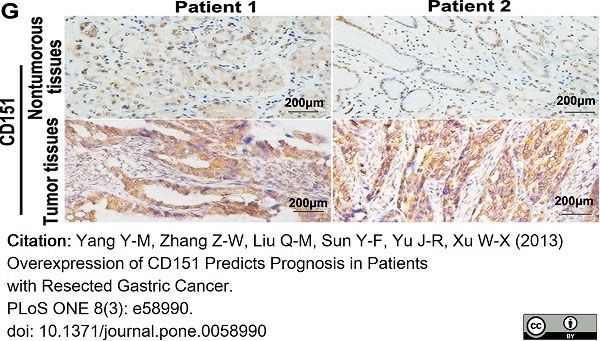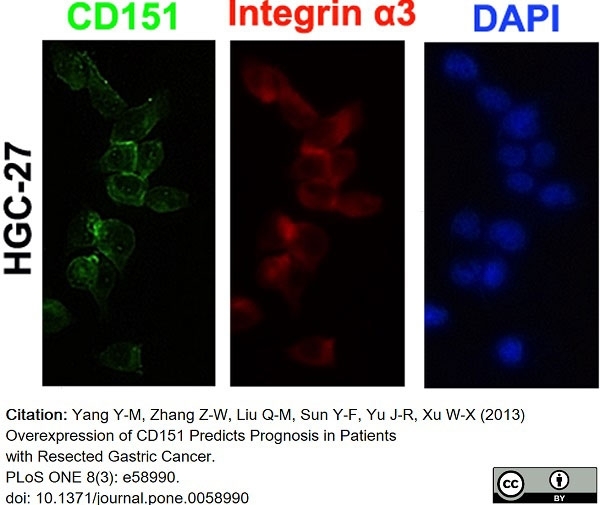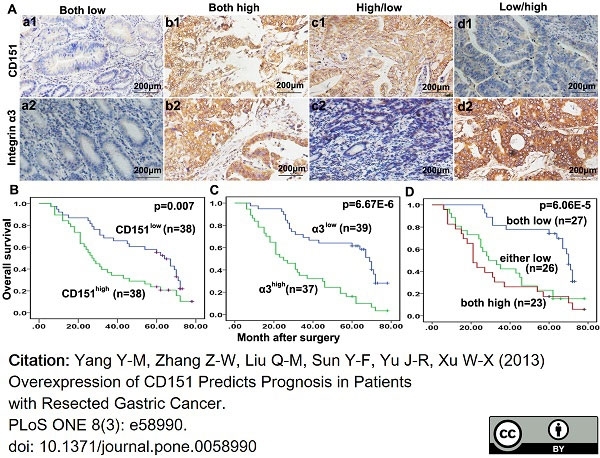CD151 antibody | 11G5a












Mouse anti Human CD151
- Product Type
- Monoclonal Antibody
- Clone
- 11G5a
- Isotype
- IgG1
- Specificity
- CD151
| Mouse anti Human CD151 antibody, clone 11G5a recognizes the human CD151 cell surface antigen, also known as PETA-3. CD151 is expressed by epithelial cells, endothelial cells, platelets, megakaryocytes, monocytes and in the renal glomeruli and proximal and distal tubules. CD151 is not expressed by lymphocytes or granulocytes. More recently CD151 has also been shown to be expressed by erythrocytes, and to carry the MER2 blood group antigen (Crew et al. 2004). It should be noted that CD151 is very closely associated with the alpha3 beta1 integrin in cells and co-immunoprecipitation may occur even in quite stringent conditions (Yauch. et al. 1998). |
- Target Species
- Human
- Product Form
- Purified IgG - liquid
- Preparation
- MCA1856T, MCA1856: Purified IgG prepared by affinity chromatography on Protein G from tissue culture supernatant
- MCA1856GA: Purified IgG prepared by affinity chromatography on Protein A from tissue culture supernatant
- Buffer Solution
- Phosphate buffered saline
- Preservative Stabilisers
- 0.09% sodium azide (NaN3)
- Carrier Free
- Yes
- Approx. Protein Concentrations
- IgG concentration 1.0 mg/ml
- Fusion Partners
- Spleen cells from immunised BALB/c mice were fused with cells of the X63.Ag8.653 mouse myeloma cell line.
- Regulatory
- For research purposes only
- Guarantee
- 12 months from date of despatch
Avoid repeated freezing and thawing as this may denature the antibody. Storage in frost-free freezers is not recommended.
| Application Name | Verified | Min Dilution | Max Dilution |
|---|---|---|---|
| ELISA | |||
| Flow Cytometry | 1/50 | 1/100 | |
| Immunofluorescence | |||
| Immunohistology - Frozen | |||
| Immunohistology - Paraffin 1 | 1/100 | ||
| Immunoprecipitation | |||
| Western Blotting 2 |
- 1 This product requires antigen retrieval using heat treatment prior to staining of paraffin sections.Sodium citrate buffer pH 6.0 is recommended for this purpose.
- 2 Clone 11G5a recognises human CD151 under non-reducing conditions.
- Flow Cytometry
- Use 10μl of the suggested working dilution to label 106 cells or 100μl whole blood
- Histology Positive Control Tissue
- Human tonsil or spleen.
| Description | Product Code | Applications | Pack Size | List Price | Your Price | Quantity | |
|---|---|---|---|---|---|---|---|
| Mouse IgG1 Negative Control | MCA928 | F | 100 Tests |
|
Log in | ||
| List Price | Your Price | ||||||
|
|
Log in | ||||||
| Description | Mouse IgG1 Negative Control | ||||||
References for CD151 antibody
-
Karamatic Crew, V. et al. (2004) CD151, the first member of the tetraspanin (TM4) superfamily detected on erythrocytes, is essential for the correct assembly of human basement membranes in kidney and skin.
Blood. 104 (8): 2217-23. -
Nishiuchi, R. et al. (2005) Potentiation of the ligand-binding activity of integrin alpha3beta1 via association with tetraspanin CD151.
Proc Natl Acad Sci U S A.102: 1939-44. -
Zheng, Z. & Liu, Z. (2006) CD151 gene delivery activates PI3K/Akt pathway and promotes neovascularization after myocardial infarction in rats.
Mol Med. 12 (9-10): 214-20. -
Zheng, Z. & Liu, Z. (2007) CD151 gene delivery increases eNOS activity and induces ECV304 migration, proliferation and tube formation.
Acta Pharmacol Sin. 28 (1): 66-72. -
Hasegawa, M. et al. (2007) CD151 dynamics in carcinoma-stroma interaction: integrin expression, adhesion strength and proteolytic activity.
Lab Invest. 87: 882-92. -
Spoden, G. et al. (2008) Clathrin- and caveolin-independent entry of human papillomavirus type 16--involvement of tetraspanin-enriched microdomains (TEMs).
PLoS One. 3: e3313. -
Ke, A.W. et al. (2009) Role of overexpression of CD151 and/or c-Met in predicting prognosis of hepatocellular carcinoma.
Hepatology. 49: 491-503. -
Shi, G.M. et al. (2010) CD151 modulates expression of matrix metalloproteinase 9 and promotes neoangiogenesis and progression of hepatocellular carcinoma.
Hepatology. 52: 183-96.
View The Latest Product References
-
Huang, X.Y. et al. (2010) Overexpression of CD151 as an adverse marker for intrahepatic cholangiocarcinoma patients.
Cancer. 116: 5440-51. -
Franco, M. et al. (2010) The tetraspanin CD151 is required for Met-dependent signaling and tumor cell growth.
J Biol Chem. 285 (50): 38756-64. -
Devbhandari, R.P. et al. (2011) Profiling of the tetraspanin CD151 web and conspiracy of CD151/integrin β1 complex in the progression of hepatocellular carcinoma.
PLoS One. 6: e24901. -
Ke, A.W. et al. (2011) CD151 amplifies signaling by integrin α6β1 to PI3K and induces the epithelial-mesenchymal transition in HCC cells.
Gastroenterology. 140: 1629-41.e15. -
Yang, Y.M. et al. (2013) Overexpression of CD151 predicts prognosis in patients with resected gastric cancer.
PLoS One. 8 (3): e58990. -
Hochdorfer, D. et al. (2016) Tetraspanin CD151 Promotes Initial Events in Human Cytomegalovirus Infection.
J Virol. 90 (14): 6430-42. -
Qiao, Y. et al. (2017) CD151, a laminin receptor showing increased expression in asthmatic patients, contributes to airway hyperresponsiveness through calcium signaling.
J Allergy Clin Immunol. 139 (1): 82-92.e5. -
Wadkin, J.C.R. et al. (2017) CD151 supports VCAM-1-mediated lymphocyte adhesion to liver endothelium and is upregulated in chronic liver disease and hepatocellular carcinoma.
Am J Physiol Gastrointest Liver Physiol. 313 (2): G138-G149. -
Burkard, C. et al. (2017) Precision engineering for PRRSV resistance in pigs: Macrophages from genome edited pigs lacking CD163 SRCR5 domain are fully resistant to both PRRSV genotypes while maintaining biological function.
PLoS Pathog. 13 (2): e1006206.
Further Reading
-
Yauch, R.L. et al. (1998) Highly stoichiometric, stable, and specific association of integrin alpha3beta1 with CD151 provides a major link to phosphatidylinositol 4-kinase, and may regulate cell migration.
Mol Biol Cell. 9 (10): 2751-65. -
Kwon, M.J. et al. (2012) Clinical significance of CD151 overexpression in subtypes of invasive breast cancer.
Br J Cancer. 106: 923-30.
- RRID
- AB_323247
- UniProt
- P48509
- Entrez Gene
- CD151
- GO Terms
- GO:0005515 protein binding
- GO:0007155 cell adhesion
- GO:0005829 cytosol
- GO:0005887 integral to plasma membrane
- GO:0005624 membrane fraction
- GO:0031581 hemidesmosome assembly
Please Note: All Products are "FOR RESEARCH PURPOSES ONLY"
View all Anti-Human ProductsAlways be the first to know.
When we launch new products and resources to help you achieve more in the lab.
Yes, sign me up